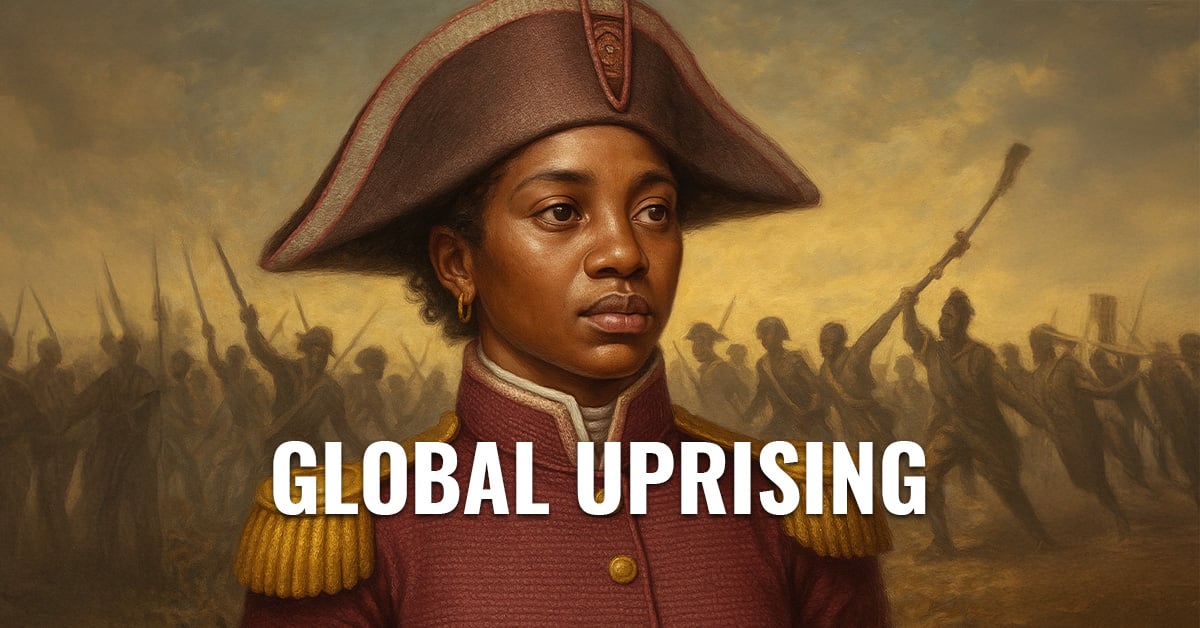Long before Haiti’s independence, there stood a warrior whose name echoes still across time—this is her story.
A Whisper in Verrettes: Birth & Origins
In 1781—though some sources vary—Sanité Bélair was born in Verrettes, in what was then Saint-Domingue (now Haiti). Her birth name was Suzanne Bélair, but history remembers her as Sanité, a name that would come to carry the weight of revolt and heroism.
Sanité was born into the class known as affranchis—people of color who, though free or freed, lived under ceilings of prejudice and restriction in a brutal colonial order. She inhabited that liminal space between enslaved and white: allowed certain privileges such as property ownership or limited education, but still bound within a system that worshiped whiteness and suppressed Black agency.
We know little of her childhood; records of women like her were rarely preserved. But we can imagine what it meant to grow up Black and free in name only, watching the world shift as enslaved Africans and free people of color murmured of rebellion. Perhaps she heard those whispers and saw quiet defiance—small acts of resistance that became lessons for life. Whatever sparked her inner fire, it would carry her into history.
The World She Inherited: Affranchis, Colonial Order & the Edge of Rebellion
To understand Sanité’s life is to understand the world she inhabited: Saint-Domingue in the late 18th century. It was France’s wealthiest colony—sugar, coffee, and cotton enriched Paris—but built on the backs of hundreds of thousands of enslaved Africans. In that structure, societies were rigidly stratified:
- Grand blancs (big white planters)
- Petit blancs (lesser whites: merchants, artisans)
- Affranchis / Gens de couleur (free people of color, often of mixed descent)
- Enslaved Black people – the vast majority, enduring unrelenting violence
Even among the affranchis, rights were fragile. Racism kept them excluded from white privilege and perpetually threatened by re-enslavement or violence.
Then came 1791, when the Haitian Revolution erupted—the first successful revolt of enslaved people in the Western Hemisphere. It was not merely local; it was part of a global Black uprising against bondage and empire.
Into that storm stepped Sanité Bélair. She would not be passive. She would not hide.
Love & Revolution: Meeting Charles Bélair
In 1796, around age fifteen, Sanité married Charles Bélair, a rising commander in the revolutionary army and, some say, a nephew or close ally of Toussaint Louverture. Their union was not only romantic—it was revolutionary.
In the fires of war, love and liberation intertwined. Marriages like theirs were bonds of shared purpose and trust. Together, Sanité and Charles became partners in destiny, their commitment deepened by the battles ahead.
She joined him not as an onlooker but as an equal—ready to fight, lead, and sacrifice.
Into the Fire: Rising in the Ranks
Sanité took up arms, first as a sergeant and later a lieutenant in Louverture’s army. She commanded both men and women and quickly became known for her discipline, intelligence, and fearless leadership.
Jean-Jacques Dessalines himself is said to have called her a tigress—a woman whose courage roared louder than fear. Her presence on the battlefield was a living defiance of colonial gender norms, proof that Haitian women were warriors in their own right.
By 1801, she had earned such a reputation that French forces placed a bounty on her head. She moved through the mountains like a shadow—strategic, fearless, and relentless.
In the Teeth of Empire: Campaigns in Artibonite & Beyond
In 1802, Napoleon Bonaparte sent his brother-in-law, General Charles Leclerc, to crush the revolution and reimpose slavery. The struggle intensified.
Sanité and Charles fought fiercely in the Artibonite region, using their deep knowledge of the land to launch guerrilla strikes against the French. She helped rally local peasants and organize defenses in mountain strongholds.
Her resolve was unbreakable—even when spies and traitors threatened the resistance. Her sense of justice was sharp and uncompromising.
But in one brutal campaign, the couple’s unit was ambushed by French General Faustin Répussard’s forces near Corail-Mirrault. Sanité was captured in the assault. Hearing of her imprisonment, Charles surrendered so they would not be separated.
The French took them in chains. Their fate was sealed.
Betrayal, Capture & Trial
In Cap-Haïtien, the couple faced a French-controlled tribunal. Charles was sentenced to death by firing squad—a soldier’s death. Sanité, because she was a woman, was condemned to decapitation, a sentence meant to humiliate.
But Sanité refused. She demanded equality in death as she had in life. She rejected the blade and insisted on being executed by musket, like her male comrades. When the soldiers tried to force her submission, she resisted until they relented.
She stood tall, unwavering, ready to meet her end on her own terms.
Defiance at the End: Her Final Stand
On October 5, 1802, Charles Bélair was executed first. Sanité watched with unflinching composure. Some accounts say she called out to him, urging courage: “Die bravely.”
Then it was her turn. She refused a blindfold, choosing to face her killers eye to eye. As the rifles were raised, she shouted the words that would echo through history:
“Viv libète! A ba esclavaj!”
(“Long live freedom! Down with slavery!”)
The volley rang out. She fell at twenty-one years old—young in years, but eternal in legacy.
The Echoes That Carried Forward
Her defiance ignited a memory. Sanité’s refusal to submit, her insistence on dying as a soldier, turned her into a revolutionary symbol for generations.
National Heroine
In time, Haiti recognized her as a national heroine. In 2004, for the bicentennial of Haiti’s independence, her image was placed on the 10-gourde banknote—the only woman in that series. She stands there still, unbowed.
Cultural Memory & Revivals
Writers and artists have continued to honor her spirit. In Opéra poussière by Jean D’Amérique, she is reimagined as both ancestor and contemporary voice, speaking across centuries to new generations of Black women rising.
Her name now echoes in movements demanding visibility for the women who fought, bled, and built nations—often erased, now reclaimed.
Global Uprising: Why Sanité Bélair Matters Now
When we step back and consider the calendar’s framing—Global Uprising, honoring Sanité Bélair in May—we see why she is not just a Haitian hero, but a figure for the world.
Black Liberation is Global
The story of Haiti’s revolt is not separate from the struggles in the U.S., West Africa, the Caribbean, Brazil, or European abolitionist movements. The Haitian Revolution was the first successful enslaved peoples’ revolution in the Atlantic world. Its reverberations shook colonial empires. Sanité’s name connects to that global lineage.
Her story invites us to remember that women were fighters, not just passive supporters. Her life demands that women’s leadership be visible, that memory be rearranged.
Naming & Power
In reclaiming her story—through a calendar, a QR-linked article, a public memory—we engage in symbolic restitution. We say: no, you will not erase her. No, you will not treat her as incidental. She was central.
Reclaiming Fire
When we reflect now, we can ask: What is our uprising? Where do we refuse to be silenced? Sanité reminds us that defiance is not optional—it is necessary. To claim dignity, we must sometimes speak our truth at risk.
Reflection Questions + Suggested Reading / Travel Bites
Reflection Questions
- What does international solidarity look like in your life?
If Sanité’s revolt was tied to a global Black resistance, how can your own activism be conscious of interconnected struggles? - How do we make women’s roles in liberation visible and valued?
What historical figures in your family, city, or country never got their rightful spotlight? How can you begin to tell those stories? - What would it mean to demand dignity in your darkest moment?
Even in systems built to degrade, there is power in self-fashioned resistance. - How do you link your freedom to others’?
Sanité’s cause was not just her own, but the cause of all who yearned to break chains—do you see your liberation as bound up with others?
A Flame Reclaimed
Sanité Bélair’s life was brief, but her flame outlives time. In the gunfire, in the final cry of “Viv libète! A ba esclavaj!”, she carved her name across generations. She reminds us that memory is a battlefield—and we must choose who is honored, who is erased.
As you hold your calendar, scan the QR, read this, and let her life challenge you. Let her voice echo: in your struggle, in your organizing, in your stories. Let May be not just a reminder—but a turning.
“Our freedom story has always been global—learning it keeps our compass true.”
May Sanité Bélair guide our steps as we reclaim flame, memory, and power.
💬 Let’s Talk:
Had you heard of Queen Nanny before this? What lessons can we take from her leadership today?
👇 Drop a comment and share this with someone who needs to know our real history.








0 Comments